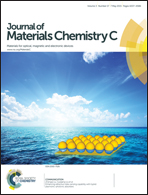Compatibility of amorphous triarylamine copolymers with solution-processed hole injecting metal oxide bottom contacts†
Abstract
Triarylamine copolymers are p-type organic semiconducting materials which have been shown to have the crucial advantages of being air-stable, forming amorphous films (critical for device uniformity over large areas) and allowing the creation of high mobility transistors and highly efficient perovskite solar cells. A key area of recent technological progress has been the development of solution-processable metal oxides as charge injection layers in organic semiconducting devices. Here we report on the synthesis of a large ionization potential (IP = 5.65 eV) silafluorene bridged triarylamine copolymer poly(silafluorene-triarylamine) (PSiF-TAA), and compare its time-of-flight (TOF) bulk hole mobility to that of a fluorene bridged triarylamine copolymer poly(fluorene-triarylamine) (PF-TAA), (IP = 5.4 eV) and the homopolymer polytriarylamine (PTAA) (IP = 5.2 eV). Using these mobility values and current–voltage measurements, we then quantify the charge injection efficiency (χ) into these polymers from three ambiently-prepared solution processed hole-injecting contacts MoO3 (aqueous nanoparticle dispersion), V2O5 (sol–gel) and chlorinated indium tin oxide (Cl-ITO) (UV – solvent assisted), and compare them to the more conventional contacts ITO and poly(3,4-ethylenedioxythiophene):poly(styrenesulfonate) (PEDOT:PSS). Whilst hole injection into PTAA is relatively unaffected by the nature of the contact, injection into PF-TAA and PSiF-TAA is greatly improved by the use of MoO3 and Cl-ITO. Despite its similar mobility and larger ionization potential compared to the homopolymer, the highest injection efficiency is achieved for PF-TAA, indicating the role of chemical design in optimizing charge injection into organic semiconductor devices.

- This article is part of the themed collection: Highlighting materials research in the UK for optical, magnetic and electronic devices

 Please wait while we load your content...
Please wait while we load your content...